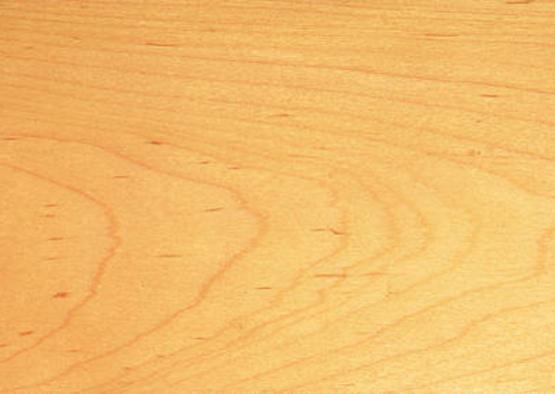American soft maple is about 25% less hard than American hard maple, making it easier to work but not as hard-wearing. It is widespread throughout eastern USA, but the big leaf maple grows only in the Pacific Northwest region.
Red Maple, Silver Maple, Bigleaf Maple, Pacific Coast Maple, Acer rubrum, Acer saccharinum, Acer macrophyllum
Acer spp.

American soft maple is the trade name for three trees of the Acer family. They grow widely throughout the eastern USA, although the Pacific Coast/big leaf maple (Acer macrophyllum) grows only in the Pacific Northwest region*. The eastern soft maple is normally called red maple in the northern states and silver maple throughout the midwest and southern states. Red maple is very similar to hard maple and is generally consistent in colour. Silver maple has a much wider range of colours and tends to have a softer texture.
American soft maple is very similar in appearance to the American hard maple, with a greyish white sapwood and light to dark reddish brown heartwood. However, due to the widespread growth of American soft maple, colouring can vary between regions. The wood is generally straight-grained although a highly figured wormy variety can occur that is not considered a defect.
About 25% less hard than hard maple, American soft maple is easier to work. It has moderate bending and crushing strength and low stiffness and shock resistance. American soft maple responds well to steam bending. It is often used as a substitute for hard maple, given the similarity in appearance, or is stained to resemble cherry. Its good working properties also make it a potential substitute for beech.
American soft maple is easily worked. It machines well and takes glue, nails and screws satisfactorily. It is considered to be an excellent timber for sawing, planning, drilling and boring. It can be stained and polished to a high finish, making it ideal for decorative purposes. The timber dries slowly and has good stability.
Soft maple is used in a range of interior applications including furniture, paneling, cabinets, mouldings and doors. It is a good woodturning timber and is also used in the construction of musical instruments.
It is expected that the availability of soft maple will improve as the demand for the timber increases.
*The properties listed on WoodSolutions refer to red maple (Acer Rubrum). The properties for Pacific coast/big leaf maple can be found at www.americanhardwood.org.
Shrinkage
| Very Low | Low | Medium | High | Very High | |
|---|---|---|---|---|---|

|

|

|
|||
Tangential : |
4.90%
|
||||
Radial : |
2.20%
|
||||
Unit Movement Tangential: |
0.27%
|
||||
Unit Movement Radial: |
0.12%
|
Strength Group

Very High |
High |
Reasonably High |
Medium High |
Medium |
Reasonably Low |
Low |
Very Low |
||
Unseasoned: |
S1 |
S2 |
S3 |
S4 |
S5 |
S6 |
S7 |
S8 |
|
|---|---|---|---|---|---|---|---|---|---|
Seasoned: |
SD1 |
SD2 |
SD3 |
SD4 |
SD5 |
SD6 |
SD7 |
SD8 |
|
Stress Grade

| Structural No. 1 |
Structural No. 2 |
Structural No. 3 |
Structural No. 4 |
Structural No. 5 |
|
Unseasoned: |
|
|
|
|
|
Seasoned: |
|
|
|
|
|
Density per Standard

Seasoned: |
610kg/m3
|
|---|---|
Unseasoned: |
735kg/m3
|
Joint Group

Very High |
High |
Reasonably High |
Medium |
Low |
Very Low |
|
Unseasoned: |
J1 |
J2 |
J3 |
J4 |
J5 |
J6 |
|---|---|---|---|---|---|---|
 |
||||||
Seasoned: |
JD1 |
JD2 |
JD3 |
JD4 |
JD5 |
JD6 |
 |
Colour

| White, yellow, pale straw to light brown | Pink to pink brown | Light to dark red | Brown, chocolate, mottled or streaky | |
 |
||||
Mechanical Properties
Modulus of Rupture - Unseasoned: |
47
|
|---|---|
Modulus of Rupture - Seasoned: |
77
|
Modulus of Elasticity - Unseasoned: |
8
|
Modulus of Elasticity - Seasoned: |
10
|
Maximum Crushing Strength - Unseasoned:  |
20
|
Maximum Crushing Strength - Seasoned: |
41
|
Impact - Unseasoned: |
|
Impact - Seasoned: |
|
Toughness - Unseasoned: |
|
Toughness - Seasoned: |
|
Hardness - Unseasoned: |
2.9
|
Hardness - Seasoned: |
3.7
|
Durability
| Low | Moderate | Reasonably High | High | |
| (0 - 5 yrs) | (5 - 15 yrs) | (15 - 25 yrs) | (more than 25 yrs) | |
In-Ground: |
 |
|||
| (0 - 7 yrs) | (7 - 15 yrs) | (15 - 40 yrs) | (More than 40 yrs) | |
Above ground: |
||||
| (0 - 20 yrs, usually < 5) | (21 - 40 yrs) | (41 - 64 yrs) | (More than 60 yrs) | |
Marine Borer Resistance: |
Lyctid Borer Susceptibility: |
Susceptible |
|---|---|
Lyctid Borer Susceptibility - Other: |
|
Termite Resistance: |
Fire Properties
Bushfire Resistance: |
Not tested
|
|---|
American soft maple is very similar in appearance to American hard maple although it is susceptible to regional colour variations. It has greyish-white sapwood and heartwood that ranges from a light to dark reddish brown. Soft maple is normally straight-grained but a wormy figure can occur. This is not considered to be a defect.
American soft maple is used in a range of interior applications, including furniture, veneer panels, doors, joinery, cabinets and mouldings. It is also a good woodturning and carving timber and is used in the construction of musical instruments.
25% softer than hard maple, American soft maple is easily worked. It machines well and nails, screws and glues satisfactorily. It can be stained and polished to produce an excellent finish, which makes it an ideal timber for decorative purposes.
